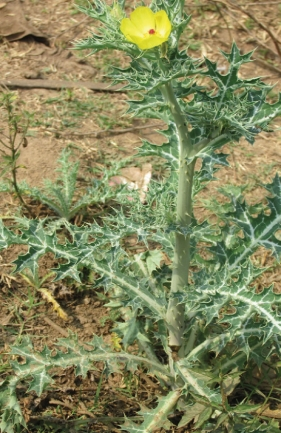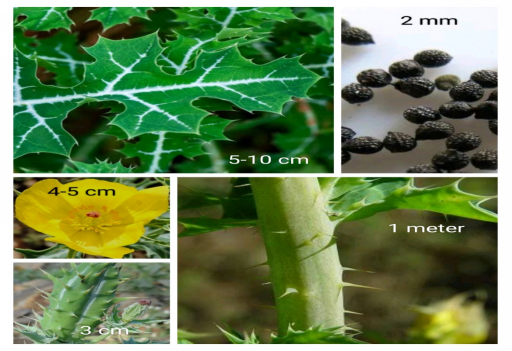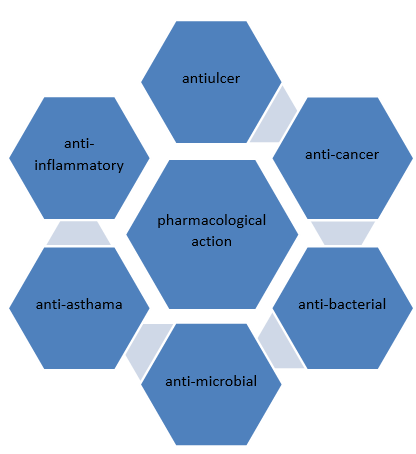Abstract
This review article presents a comprehensive analysis of the chemistry and pharmacology of Argemone Mexicana. a valuable medicinal plant utilized in various traditional medicine practices. It offers an updated overview of the chemical properties and pharmacological applications of Argemone Mexicana, which is recognized for its therapeutic benefits. This plant is a member of the Papaveraceae family, commonly referred to as the poppy family, which encompasses 42 genera and approximately 730 species of flowering plants, all of which hold significant ethnopharmacological relevance. Globally, Argemone Mexicana L. is employed in the treatment of numerous ailments, including cancer, bacterial and microbial infections, peptic and oral ulcers, as well as fungal infections, inflammation, malaria, jaundice, and various skin disorders. The species is known to produce a diverse array of chemical compounds, such as long-chain aliphatic alcohols, terpenoids, steroids, polysaccharides, carboxylic acids, flavonoids, and various phenolic compounds. This study also addresses the toxicity and safety assessments associated with the use of this plant and its constituents. While the plant exhibits significant medicinal properties, certain components may also present toxic effects. Pharmacological and clinical research on the various chemical constituents of A. Mexicana has yielded promising findings, underscoring the necessity for further systematic investigations into this therapeutic plant and its active compounds. Comprehensive and detailed research that considers all pertinent factors remains essential.
Keywords
Argemone Mexicana, traditional medicine, Anti-bacterial, Pharmacology
Introduction
India is widely recognized for using medicinal herbs, which have long been employed in traditional Indian medicine. Currently, many compounds have been isolated from plants to treat many ailments. Plants have abundant biological and medicinal qualities, which make them highly beneficial origin of chemical compounds with possible medicinal properties. The plant Argemona Mexicana L. is also medicinal plant. To treat various diseases or disorders. [1] The biological source of this plant is, the plant also known as a Mexicana Pricky Poppy. It is annual herb native to South America. Biological aspects of the Argemona Mexicana L. plants are reproduction, seed dispersal, pharmacological activity, chemical constituents, and traditional medicines. [2] (Table 1) Argemone Mexicana Linn, commonly referred to as the Satyanashi Plant, belongs to the class Magnoliopsida, the subclass Magnoliidae, the order Papaverales, and the family Papaveraceae. [1] (Fig. 1) Research on medicinal plants has been able to overcome the issues with synthetic medications in terms of preserving low toxicity and fewer adverse effects. [3] Many plants' ethnopharmacological qualities have been reported during the past few decades. Ethnopharmacological properties like Antimicrobial activity, Anti-bacterial, Cytotoxic activity, Antidiabetic activity, Ant arthritic activity, Anti-inflammatory, Antioxidant activity, Antituberculosis activity, Antiulcer activity, Wound healing activity. [1] Show in (Fig. 3) The relevance of the plants in Mexican and Mexican American popular medicine in the United States is the main justification for concentrating on a comprehensive analysis of Mexican herbal medicine. The review focuses on the molecular structure of alkaloids found in the seeds of Argemone Mexicana Linn, commonly known as prickly poppy, which is important in traditional medicine practices in Mexico and India. [4] These seeds exhibit toxic, bactericidal, hallucinogenic, fungicidal, and insecticidal properties attributed to isoquinolines and various alkaloids, including sanguinarine and berberine. A computational study utilizing computer simulations is employed to analyze the molecular geometry of these alkaloid compounds. The key active compounds identified in the seeds include allocryptopine, berberine, chelerythrine, copsitine, dihydrosanguinarine, protopine, and sanguinarine. The effects of these alkaloids are reported to be twice as potent compared to other groups. [4] This plant exhibits significant antioxidant and antimicrobial properties, along with cytotoxic effects on human cancer cell lines, making it valuable for treating various diseases. A. Mexicana, with its extensive medicinal uses and diverse secondary metabolites, shows considerable potential as a candidate for drug discovery. This paper outlines the cultivation techniques for A. Mexicana and provides an initial overview of the cytotoxic activities associated with its various parts (seeds, leaves, inner and outer roots) when extracted using methanol or hexane for the chambers of the seven rays. [5]

(Fig. 1 Argemona Mexicana Linn)
Table No. 1: Biological Aspects of Argemona Mexicana Linn
|
Sr. no.
|
Biological Aspects
|
Description
|
|
1
|
Reproduction
|
A single plant of Argemona Mexicana L. can yield up to 30,000 seeds annually through seed production. [6]
|
|
2
|
Seed dispersal
|
In addition to falling close to the current plant, seeds can also spread by water, birds, contaminated soil, moving cars, and live sparks. [6]
|
|
3
|
Chemical constituents
|
The plant containing alkaloids, flavonoids, anthracenosides, carbohydrates, tannins, saponins and terpenoids and steroids. [2]
|
|
4
|
Pharmacological activity
|
Antibacterial, Antifungal, Antiprotozoal, Anti-inflammatory, Antiviral, spasmolytic, Antioxidant, Anti cancer, Anthelmintic, Antimicrobial, Antiasthmatic, Antimalarial, Anti-urolithiasis. [1]
|
|
5
|
Traditional medicines
|
Diuretics and wound healing treatment of dropsy, jaundice, ophthalmic, scabies, and urinary stones. Used as a purgative and destroys worms. [1]
|
Pharmacognosy
In traditional Mexican medicinal practices, there's a wide range of treatment methods, each with their own favored plant components for various ailments. It's widely recognized that the positive impacts of medicinal herbs come from the active ingredients in the entire plant, its various parts (such as flowers, fruits, roots, or leaves), the plant extracts, or mixes of these extracts, whether they are in their raw form or after processing. Pharmaceutical scientists accustomed to single-agent therapy with specific treatment substance may be surprised to learn that various active compounds in herbal treatments work synergistically. The various active ingredients found in Mexican herbal treatments serve as an illustration of these phenomena. [3] The morphology of the plant show in table no. 2
Table NO.2: Morphology of Argemone Mexicana
|
Sr. No.
|
Plant part
|
Size
|
Colour
|
Chemical Constituent
|
|
1.
|
Whole Plant
|
1m
|
pale bluish-green
|
Alkaloids, Flavonoids
|
|
2.
|
Leaves
|
5- 10 cm
|
Green white
|
Terpenoids, Flavonoids
|
|
3.
|
Flower
|
4-5cm
|
Terminal Yellow
|
Terpenoids, Amino acid, Flavonoids
|
|
4.
|
Capsule
|
3cm
|
green to straw
colour
|
Alkaloids
|
|
5.
|
Seeds
|
2mm
|
dark brown to blackish
|
Alkaloids, Long chain Alcohols, Flavonoids, Phenolic and Aromatic Acid, Miscellaneous
|
|
6.
|
Roots
|
30-60 cm
|
woody taproot; latex yellowish
|
Steroids
|
|
7.
|
Spines
|
-10mm
|
Green White
|
Alkaloid
|

(Fig. 2 Morphology of Argemone Mexicana L.)
Chemical and Pharmacological Considerations
1. Anticancer activity:
Isolated alkaloids from Argemone Mexicana have been extensively studied for their cytotoxic properties various cancer cell lines were tested, including HONE-1 and NUGC, A-549, HT-29, and HL-60. While there has been considerable pharmacological research on species within the Papaveraceae family, not all have been comprehensively investigated. Our research team possesses substantial expertise in the evaluation of Mexican flora, particularly Argemone Mexicana, among others. [7] This isoquinoline alkaloid displays a variety of biological and pharmacological properties, including hepatoprotective, antiparasitic, antimicrobial, anthelmintic, antioxidant, and hypoglycemic effects. Notably, BER has been linked to several promising research efforts that could result in various therapeutic applications, especially concerning antitumor activity and carcinogenicity. Later thinks about have underscored BER's capacity to repress the expansion of tumor cells, display cytotoxic impacts, and initiate apoptosis in cancer cells. Initial findings from research involving human cancer cell lines indicate that BER may serve as a potential candidate for cancer therapy. This promise has led to numerous studies focused on improving the efficacy and specificity of BER. Argemone Mexicana is recognized for its extensive range of pharmacological activities, [8] as outlined in Table No. 3. Our examination centered on assessing the chemical and natural properties of plant extricates for their potential applications in phytotherapy. In a earlier audit, we analyzed the cytotoxic impacts of the unrefined methanolic extricate of Argemone Mexicana on the reasonability of HEP-G2 (human hepatocellular carcinoma) and L5178Y-R (murine lymphoma) cells in vitro. The show consider points to supply experiences into the methanol extricate of Argemone Mexicana, its divisions gotten from solvents of changing extremity, and the alkaloid BER, recognized as the most dynamic fixing in Argemone Mexicana. The essential objective is to report on the antiproliferative effects against both typical and cancer cell lines, together with the anti-hemolytic properties of these compounds. [7]
2. Antiasthma activity:
The word "asthma" comes from a Greek word that means "breathless." Asthma is chronic inflammation condition of the respiratory system. Chronic inflammation is linked to an excessive airway-narrowing reaction to certain stimuli, including viruses, allergens, and physical activity. This causes recurring bouts of coughing, chest tightness, wheezing, and/or dyspnea, which can vary in intensity and duration over time. A leading source of illness and mortality in many nations has been asthma. The majority of people with asthma have bronchial hyper responsiveness as a trait. Asthma is characterized by the nearness of incendiary cells within the aviation route, counting eosinophils, macrophages, pole cells, epithelial cells, and actuated lymphocytes. These cells are responsible for producing various cytokines, adhesion molecules, and other mediators. [9] The anti-asthmatic impacts of the ethanolic extricate of Argemone Mexicana, in conjunction with its chloroform and ethyl acetic acid derivation divisions, were assessed through both in vitro and in vivo models. In vitro evaluations included separated guinea pig ileum and tracheal chain arrangements, whereas in vivo thinks about included milk-induced eosinophilia in mice and bronchospasm initiated by histamine and acetylcholine in guinea pigs. The ethanol extricate and ethyl acetic acid derivation division altogether lessened the withdrawal of the disconnected guinea pig ileum and trachea caused by histamine at a measurement of 10 mg. Besides, the ethanol extricates of Argemone Mexicana, managed at measurements of 150, 250, and 350 mg/kg body weight, outstandingly amplified the inactivity term of writhings in a dose-dependency way when compared to the standard treatment (Ketotifen fumarate). By and large, the ethanol extricate from the stem of Argemone Mexicana has appeared significant anti-asthmatic action. [10]
3. Anti-Inflammatory activity:
These days, it is recognized that many chronic illnesses have an etiologic factor that is an ongoing, unchecked inflammation. Even though inflammation serves as a defense mechanism, a number of diseases can be brought on, maintained, or made worse by the intricate processes and mediators involved in inflammatory response. Furthermore, a number of writers have demonstrated the connection between inflammation and pain in the development of various illnesses. Many plants with medicinal potential are a good alternative in the fight against pain and inflammation because they have anti-inflammatory qualities. [5] The effects of Argemone Mexicana root ethanol extract's anti-inflammatory properties on paw edema caused by carrageenan. Although the highest inhibition occurred in the late phase (47.37%, P < 0> [5]
4. Anti-urolithiatic activity:
The objective of this study was to evaluate the anti-urolithiatic properties of leaf extracts from Argemone Mexicana L. as a possible natural alternative to mitigate the side effects linked to modern synthetic drugs. The effectiveness of the extracts in inhibiting the formation of calcium oxalate crystals was assessed. [11]
In-vitro study:
The methanol leaf extricate of A. Mexicana shown a eminent restraint rate of 72.26% within the nucleation measure, outperforming the standard cystone drug's restraint of 62.96%, with results regarded noteworthy. Within the conglomeration measure, the extricate appeared an indeed higher restraint rate of 77.24% compared to cystone's 69.33% at a concentration of 100 mg/ml. Moreover, infinitesimal investigation clearly demonstrated that the extricates from A. Mexicana clears out have the capability to break down calcium oxalate precious stones. [12]
Kidney stone are shaped when gem nucleate are develop, which are driven by super immersion of pee with natural fabric.
5. Anti-Bacterial activity:
It has been reported that plants demonstrate potent antimicrobial properties. Research on plants as sources of antibiotics opened up a new era in the study of pharmacology. This research aimed to evaluate the antibiotic properties of Argemone Mexicana L. and its effectiveness against pathogenic bacteria and fungi. The process involved the extraction of flowers, berries, and leaves utilizing three different solvents: methanol, ethanol, and chloroform. Subsequently, antibacterial and antifungal assays were performed employing agar disc diffusion and agar tube dilution techniques, respectively. The antimicrobial effectiveness of ethanol, methanol, and chloroform was approximately 80% against most bacterial strains. More than half of the antifungal activity was noticed. Raw plant extracts showed strong effectiveness of 50-60%. Nanoparticle synthesis of plant extract: These nanoparticles have been shown to be effective against anti-biotic-resistance bacteria. The organic molecules from the extract and the silver nanoparticles work together to increase inhibition of bacterial growth. [13] The oil extracted from Argemone Mexicana seeds is known to contain harmful quaternary benzophenanthridine alkaloids, with sanguinarine making up approximately 90% and dehydrosanguinarine around 5%. Additionally, it includes smaller amounts of chelerythrine and coptisine, as well as trace levels of berberine and protopine, all of which fall under the category of isoquinoline alkaloids. The seeds themselves are composed of 30-35% oil, which contains 0.13% alkaloids. Argemone seeds can occasionally contaminate cereal grains, but their oil is more commonly found mixed with edible oils, especially mustard oil sourced from Brassica nigra. In some areas, it is quite typical for argemone seed oil to be combined with mustard oil. [13]
6. Anti-ulcer activity:
Peptic ulcer (PU) is a condition affecting the stomach and/or duodenum. Peptic ulcer disease is a prevalent gastrointestinal condition that impacts a significant portion of the global population in their everyday lives. . This malady is characterized by the disintegration of the mucous layer lining the stomach or duodenum. Ulcers that form in the duodenum are referred to as duodenal ulcers, while those that occur in the stomach are known as gastric ulcers. The former mainly occur in young people, while the latter occur more frequently in the elderly. Reducing gastric pH, volume and acidity: An ethanol leaf extract of A. Mexicana was show to reduce gastric pH, volume and acidity. [14] The predominance of peptic ulcer malady (PUD) is around 10% in guys and 4% in females. This condition ordinarily emerges from a disturbance between destructive gastric components (such as corrosive, pepsin, and responsive oxygen species) and defensive mucosal components (counting prostaglandins, bicarbonate, mucin, and antioxidant chemicals). Contributing components incorporate Helicobacter pylori contamination, over the top utilize of nonsteroidal anti-inflammatory drugs, smoking, dietary propensities, liquor utilization, and both physical and mental push. [15]
Plant extract: Research on the methanol and aqueous extracts of Argemone Mexicana revealed that they:
1. Decreased the ulcer index, ulcer score, and ulcer area measurements.
2. A study on a 70% hydro-ethanol leaf extract demonstrated the anti-ulcer properties of A. Mexicana leaves.
3. A. Mexicana is a wild plant utilized in traditional medicine across Nigeria and various African nations for the treatment of peptic ulcer disease. It is also incorporated into Ayurveda, Siddha, Unani, and Homeopathic practices.

Figure 3
Mechanism of action of Argemone Mexicana L.
(Table No. 3) Mechanism of action of Argemone Mexicana L.
|
Sr. no.
|
Activity
|
Mechanism of Action
|
|
1.
|
Anticancer
|
Decreased expression of TNF-alpha and the NF-kB signaling pathway:
It was demonstrated that an ethanol extract of Argemone Mexicana leaves might decrease TNF-alpha expression and control the NF-kB signaling pathway, potentially preventing cancer.
Cytotoxic activity
Review has shown that the methanol extract from Mexicana leaves exhibits cytotoxic effects on human cancer cells as well as on healthy fibroblasts derived from mice. [8] [13]
Modulation of epigenetics enzyme
Sanguinarine, isolated from Argemone Mexicana roots, can affect epigenetic enzyme such as KAT3, CARM1 AND G9a, which can modulate epigenetic mediated gene transcription. [7]
Inhibition of oncogene and tumor suppressor mRNA level
The methanol extract of Argemone Mexicana roots may affect colon cancer cells by inhibiting the level of c-MYC
mRNA of the oncogene and the tumor suppressor APC.
|
|
2.
|
Antiasthma
|
Vascular Smooth muscles:
Vascular smooth muscle unwinding is famous with the methanol extricate of the plant, which successfully decreases compressions actuated by norepinephrine. [9]
Anxiolytic Like Effects
The ethanol extract and alkaloid-enriched extract exhibit anxiolytic effects comparable to those of diazepam.
Anti-Asthmatic Effect
Additionally, the ethanol extract demonstrates notable anti-asthmatic properties. [9]
|
|
3.
|
Anti-Inflammatory
|
Edema Inhibition
The ethyl acetate extract derived from the fruit of Argemone Mexicana may possess properties that help alleviate edema. [5]
Suppression of Exudate
The ethyl acetic acid derivation extricate determined from the natural product of Argemone Mexicana has the capacity to restrain exudate.
Collagen Tissue Formation
The extract derived from ethyl acetate the fruit of Argemone Mexicana may enhance collagen tissue formation.
Neovascularization
The extract derived from ethyl acetate the fruit of Argemone Mexicana can promote neovascularization. [16]
Increase in Tensile Strength
The extract derived from ethyl acetate the fruit of Argemone Mexicana can enhance tensile strength.
|
|
4.
|
Anti- urolithiatic
|
In-vitro studies
Microscopic assays have demonstrated that extracts from the leaves of Argemone Mexicana are capable of dissolving calcium oxalate crystals. A study demonstrated that the methanol extract derived from the leaves shows anti-urolithiatic effects when used at a concentration of 100 mg/ml. [11]
Animal studies
In a distinct study, administering a methanol extract from A. Mexicana orally to animals with urinary bladder stones induced by zinc discs led to a decrease in both the formation and weight of the stones. [12]
|
|
5.
|
Anti-Bacterial
|
Chloroform extract derived from seeds
Chloroform extract derived from seeds has demonstrated antibacterial properties against both Gram-positive and Gram-negative bacteria.
Cold aqueous and methanol extract of leaves
Cold watery and methanol extricates inferred from clears out have illustrated the capacity to restrain the development of a few bacterial strains, such as Staphylococcus aureus, Bacillus cereus, Escherichia coli, and Pseudomonas aeruginosa.
Nanoparticle synthesis of plant extract
The synthesis of nanoparticles from plant extracts has proven effective against antibiotic-resistant bacteria. The combination of organic molecules from the extract and silver nanoparticles enhances the inhibition of bacterial proliferation.
|
|
6.
|
Anti-Microbial
|
Chelerythrine and berberine
These two compounds were identified in The extract of methanol derived from the roots and leaves of Argemone Mexicana. The roots contain both compounds, whereas the leaves do not contain Chelerythrine.
Protopine and sanguinarine
These alkaloids were isolated from the plant and exhibit molluscicidal activity.
|
|
7.
|
Anti-ulcer
|
Lowering gastric pH, volume, and acidity
An ethanol leaf extract of Argemone Mexicana demonstrated the ability to lower gastric pH, volume, and acidity levels. [14]
Enhancing glycoprotein and mucus levels
The same extract was found to enhance the levels of glycoprotein and mucus.
Boosting antioxidant enzyme activity
Additionally, the extract was effective in boosting the activity of antioxidant enzymes.
Decreasing the ulcer index, ulcer score, and ulcer area:
The fluid and methanol extricates of A. Mexicana illustrated a critical diminishment within the ulcer list, ulcer score, and ulcer range estimations. [15]
|
Toxicity and safety evaluation of A. Mexicana
The growing trend of individuals utilizing herbal remedies for self-medication has sparked heightened interest among clinical pharmacologists concerning the safety and effectiveness of these treatments in recent years. Healthcare professionals, including physicians, nurses, pharmacists, and social workers, often possess limited understanding of the toxicology and pharmacology associated with the most commonly used herbal therapies for their patients. Various parts of plants are favored for treating specific ailments, and traditional Mexican medicine acknowledges a diverse array of healing practices. [16]
(Table No. 4) Evaluation of safety and toxicity
|
Evaluation of Toxicity
|
Evaluation of Safety
|
|
1. Toxicity: The intake of mustard oil in conjunction with Argemone Mexicana oil may result in epidemic dropsy, which can present symptoms including swelling, anemia, and congestive heart failure. Additional possible symptoms are diarrhea, vomiting, skin irritation, coughing, and respiratory issues.
|
1. A Phytotherapy derived from Argemone Mexicana has been determined to be safe and well-tolerated in humans.
|
|
2. Hepatotoxicity: Research involving rats has demonstrated that sanguinarine exhibits hepatotoxic properties, resulting in decreased liver mass, abdominal swelling, and liver hypertrophy.
|
2. The leaves of Argemone Mexicana were shown to be non-toxic in rat studies.
|
|
3. Acute toxicity: The intraperitoneal administration of Argemone Mexicana to mice has established an LD50 value of 450 mg/kg of body weight.
|
3. A hemolysis assay conducted on human erythrocytes indicated that the crude extract from the stem and leaves of Argemone Mexicana exhibited no significant cytotoxic effects.
|
|
4. Organ affect: Argemone Mexicana can target the liver, lungs, kidney and heart.
|
4. Argemone Mexicana is utilized in various traditional medicinal systems, including ayurveda, siddha, unani, and homeopathy.
|
|
5. Mechanisms of toxicity: Sanguinarine is thought to disrupt the oxidation process of pyruvic acid, resulting in the expansion of capillaries and small arterioles. This disruption could potentially result in necrotic changes within liver tissue, thereby contributing to its hepatotoxic effects.
|
|
CONCLUSION:
Based on its diverse therapeutic properties recognized in traditional medicine, it is clear that Argemone Mexicana is a significant medicinal herb. Moreover, scientific studies have validated its pharmacological efficacy. This plant holds potential for the creation of new medications that do not produce adverse effects. It is also crucial to prioritize the conservation and appropriate use of Argemone Mexicana plants.
REFERENCES
- Charles Lekhya Priya and Kokati Venkata Bhaskara Rao, ETHANOBOTANICAL AND CURRENT ETHANOPHARMACOLOGICAL ASPECTS OF ARGEMONE MEXICANA LINN: AN OVERVIEW. IJPSR (2012), Vol. 3, Issue 07.
- Lourdes Rodriguez-Fragoso a, Jorge Reyes-Esparza a, Scott W. Burchiel b,Dea Herrera-Ruiz a, Eliseo Torres c. Risks and benefits of commonly used herbal medicines in Mexico. 2007, Toxicology and Applied Pharmacology 227 (2008) 125–135.
- Goutam Brahmachari, Dilip Gorai, Rajiv Roy. Argemone mexicana: chemical and pharmacological aspects. May/Jun. 2013: Revista Brasileira de Farmacognosia Brazilian Journal of Pharmacognosy 23(3): 559-575,
- Joel H. Elizondo-Luevano , Ramiro Quintanilla- Licea , Imelda N. Monroy-García , Miroslava Ka?cániová , Uziel Castillo-Velázquez , Aldo F. Bazaldúa-Rodríguez , Lourdes M. Garza-Vega ,Ángel D. Torres-Hernández 6 and Abelardo Chávez-Montes. Assessment of Anticancer Properties of Argemone mexicana L. and Berberine: A Comparative Study. Plants 2024, 13, 1374
- Rohit Singh, Neelesh Chaubey, Rajeev Kumar Mishra, Evaluation of Anti-Asthmatic Activity of Ethanolic Extract of Argemone mexicana Stems. 2021; 7(1): 39-44
- Prathamesh B. Gund, Rutuja B. Humbe and Priyanka K. Shinde. STUDY OF ANTHELMINTIC ACTIVITY OF ARGEMONE MEXICANA ROOTS AGAINST INDIAN EARTHWARM. 2024; Volume 13’ Issue 7, 470-477
- Araujo M. G. S., Silva A. L. L. , Silva-Junior E. F. Santos Junior P. F. S. Santos M. S. Bernardo T. H. L, Bastos M. L. A, Alexandre-Moreira M. S. Araújo-Júnior J. X. and Veríssimo R. C. S. S. Evaluation of antimicrobial and cytotoxic potential of Argemone mexicana L. 2015, 7(12):482-489, ISSN : 0975-7384 ;CODEN(USA) : JCPRC5.
- Ravi Kiran Chilivery, Sangilimuthu Alagar, Teepica P Darsini, In Vitro Anti-Urolithiasis Potentials of Argemone mexicana L. Leaves. Current Clinical Pharmacology, 01 Jan 2016, 11(4):286-29
- Ricardo Gobato, Desire Francine Gobato Fedrigo, Alekssander Gobato, Molecular geometry of alkaloids present in seeds of mexican prickly poppy.
- J.K. Yamamoto-Furusho, Y. Gutiérrez-Grobe. J.G. López-Gómez F. Bosques-Padilla, J.L. Rocha-Ramírez , Mexican Consensus on Ulcerative Colitis Working Group. The Mexican consensus on the diagnosis and treatment of ulcerative colitis. Revista de Gastroenterología de México. 2018; xxx(xx):xxx---xxx.
- Delia Sansores-España, Alfredo Geovanny Pech-Aguilar, Karol Guadalupe Cua-Pech, Isabel Medina-Vera, Martha Guevara-Cruz, Ana Ligia Gutiérrez-Solis, Juan G Reyes-García, Azalia Avila-Nava. Plants Used in Mexican Traditional Medicine for the Management of Urolithiasis: A Review of Preclinical Evidence, Bioactive Compounds, and Molecular Mechanisms. Molecules 2022, 27(6), 2008; https://doi.org/10.3390/molecules2706200
- Joel H. Elizondo-Lue´vano , Roc?´o Castro-R´ ?os, Eduardo Sa´nchez-Garc?´a, Magda E. Herna´ndez-Garc´ ?a , Javier Vargas-Villarreal , Osvelia E. Rodr?´guez-Luiss, and Abelardo Cha´vez-Monte. In Vitro Study of Antiamoebic Activity of Methanol Extracts of Argemone mexicana on Trophozoites of Entamoeba histolytica HM1-IMSS. Canadian Journal of Infectious Diseases and Medical Microbiology Volume 2018, Article ID 7453787, 8 pages https://doi.org/10.1155/2018/7453787
- Orozco-Nunnelly DA, Pruet J, Rios-Ibarra CP, Bocangel Gamarra EL, Lefeber T, et al. (2023) Correction: Characterizing the cytotoxic effects and several antimicrobial phytocompounds of Argemone mexicana. PLOS ONE 18(6): e0287803. https://doi.org/10.1371/journal.pone.028780
- Vilas N. Deshmukh, Evaluation of Anti-Inflammatory Activity of Argemone mexicana Linn. Root Extract. Human Journals Research Article December 2017 Vol.:11, Issue:1.
- Oluwafemi Ayodeji Idowu, Rotimi Olusanya Arise. Ameliorative and Safety Characteristics of Argemone mexicana in Indomethacin-Induced Peptic Ulcer. 2024; Pharmaceutical Fronts. Issue 03 · Volume 06· September 2024DOI: 10.1055/s-014-60299
- Perla Patricia Ochoa- Garcia, Jaime Sanchez- Salas, Ricarda Trejo-Calzada. Morphometry and Mineral Content in the seed and oil of two species of Argemone Mexicana Linn (Papaveracea) in the Central of the Chihuahuan Desert. 2024. Python (0031-9457)93(2).
- Selvaraja Varun, Sudha Sellappa. In vitro Screening of phytochemicals and anticancer activity of Argemona Mexicana leaf extract. Method 11, 12; 2014
- RD Bhalke, SA Gosavi, Anti-stress and Anti-Allergic effect of Argemone Mexicana stem on asthma. 2009; Arch Pharma Sci Res 1(1), 127-129.


 Khushabu Sonawane*
Khushabu Sonawane*
 Sneha Shinkar
Sneha Shinkar
 Dr. T. R. Patave
Dr. T. R. Patave



 10.5281/zenodo.14607878
10.5281/zenodo.14607878